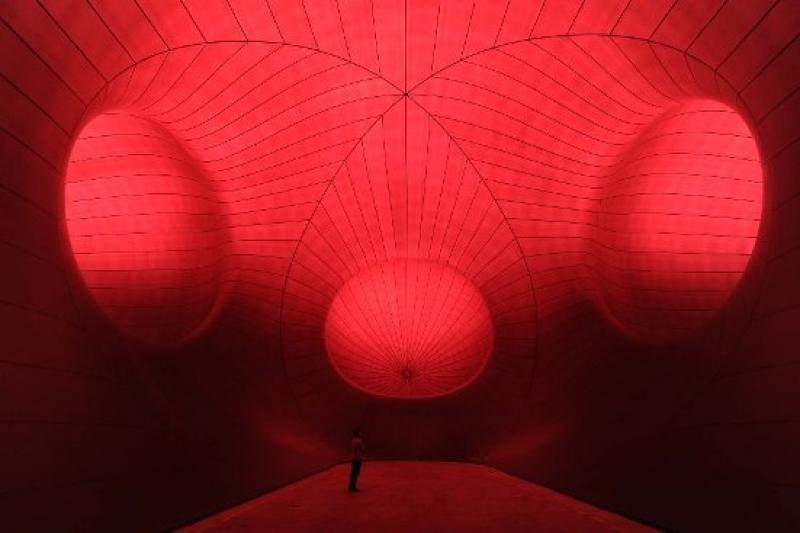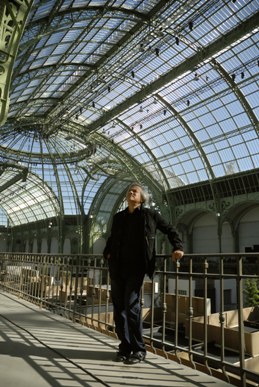theartsdesk in Paris: Inside Anish Kapoor's Leviathan | reviews, news & interviews
theartsdesk in Paris: Inside Anish Kapoor's Leviathan
theartsdesk in Paris: Inside Anish Kapoor's Leviathan
It's monumental, it's megalomaniacal and it's British

All aboard! 4000 visitors a day are queuing up for a voyage in the belly of a whale. Anish Kapoor’s Leviathan, a commission for the Monumenta series at the Paris Grand Palais, is a runaway success, one of those Zeitgeist-attuned mega-installations that double up as fairground attraction and religious experience.
The crowd walks straight into the giant inflatable from the entrance, each person admitted to the inner sanctum, one by one, through an air-locked revolving door. The rosy light and foggy atmosphere have an otherworldly quality. The punters are awestruck. Even the camera-phone addicts, texting images to friends, seem to be subdued. “It’s like arriving on a different planet," someone whispers. A man in a suit wanders around bemused, trailing his carry-on luggage as if he had boarded the wrong spaceship. The womb-like effect of Leviathan is intense, at once claustrophobic and comforting.
 The space inside Kapoor’s mammoth belly is reminiscent of a cathedral: the vision embodied in the work and the technological prowess displayed in its massive scale and elegant forms is almost superhuman. Cathedral-builders displayed something close to hubris - those towers and spires reached for something beyond the ordinary. Leviathan displays the same heroic daring and the star-cult the French have loaded on the artist – they have used his face to advertise the piece - is in many ways appropriate.
The space inside Kapoor’s mammoth belly is reminiscent of a cathedral: the vision embodied in the work and the technological prowess displayed in its massive scale and elegant forms is almost superhuman. Cathedral-builders displayed something close to hubris - those towers and spires reached for something beyond the ordinary. Leviathan displays the same heroic daring and the star-cult the French have loaded on the artist – they have used his face to advertise the piece - is in many ways appropriate.
But there is more to Leviathan than ego and megalomania. The design is brilliant in conception and exquisite in realisation. In a body of work that has often explored the darker sides of Eros, Kapoor has so far only alluded to the secret places that dwell beyond enticing orifices. In Paris, we get full penetration and the experience doesn’t disappoint. Once inside the womb, though, the rosy colour and the architecture of the space suggest the chambers of the heart as much as other hidden parts of the body. What is clear is that we are inside something and the feeling of being enclosed is curiously palpable.
After the first impact – the sublime as wow-factor – the subtleties of the piece become gradually apparent. As the light outside the building changes, the atmosphere within Leviathan shifts. Kapoor has exploited the delicate tracery of the Grand Palais’ steel beams, pillars and girders with imagination. As the sun comes out, the rich pattern of shadows is projected onto the walls of the inflatable and, depending on the intensity of the sunshine, the light-show is dramatically hard-edged or gently soft-focus. When clouds drift by, the walls close in and the place becomes more tangibly womb-like. The interplay between these states plays on both intellect and emotions. The central chamber branches out in three directions: the one that faces you as you go in, a kind of tantric altar, presents a mesmerising vanishing point, a dark circle at the meeting point of more than a dozen seams in Leviathan’s synthetic membrane. The side chambers have a different feel as they drop away from a soft rounded rim into an invisible space which the visitor can only imagine. As in other pieces, Kapoor plays with our desire for the hidden and the impact such absent spaces have on our experience of presence.
Outside and into Leviathan: click on the images to enlarge
[bg|/ART/jasper_rees/Leviathan]
The play between inner and outer is most awe-inspiring when emerging from the belly of the whale to the exterior of the structure, which has been skilfully hidden from view as visitors are initially funnelled in through the airlock from the street. There is a sense of relief as well as surprise, and a simple pleasure in knowing how the thing works, a hit of concrete reality which makes the remembered magic of the inner sanctum all the more inspiring. Not that the black inflatable isn’t awe-inspiring as it fills the vastness of the Grand Palais space, but the heart of the Leviathan experience lies in an original variation on the theme of birth suggested by the passage from the soft darkness of the womb to the near-blinding light outside. This is where the artist touches on the world of dreams and provides, as he has done in his best work, a moment of perception-bending transformation. This is more than just clever illusionism – though this is part of the entertainment and it draws the crowds – but a kind of revelation that can be experienced in the body as well as the mind and the emotions.
Paris’s love affair with megalomania, from the phallic dare of the Eiffel Tower to Mitterrand’s self-promoting “grand projets”, may sometimes seem a little grandiose, but there is no doubt that these gestures sometimes pay off, not just in terms of bringing tourists to the French capital. All the Monumenta projects so far have been remarkable and the vast space of the Grand Palais has inspired Richard Serra, Anselm Kiefer and Christian Boltanski to create massive installations that have given their work a setting which has magnified its power. For Kapoor as well, the Grand Palais has worked a magic that was not present in his Turbine Hall commission Marysas or the disappointingly bitty show at the Royal Academy last year. The voyage in and out Leviathan offers a thrilling and dream-like experience along with a series of many-layered aftershocks that linger in the mind.
- Anish Kapoor's Leviathan at the Grand Palais, Avenue Winston-Churchill 75008, Paris until 23 June
- Read theartsdesk Q&A with Anish Kapoor
Share this article
The future of Arts Journalism
You can stop theartsdesk.com closing!
We urgently need financing to survive. Our fundraising drive has thus far raised £49,000 but we need to reach £100,000 or we will be forced to close. Please contribute here: https://gofund.me/c3f6033d
And if you can forward this information to anyone who might assist, we’d be grateful.

Subscribe to theartsdesk.com
Thank you for continuing to read our work on theartsdesk.com. For unlimited access to every article in its entirety, including our archive of more than 15,000 pieces, we're asking for £5 per month or £40 per year. We feel it's a very good deal, and hope you do too.
To take a subscription now simply click here.
And if you're looking for that extra gift for a friend or family member, why not treat them to a theartsdesk.com gift subscription?
more Visual arts
 'We are bowled over!' Thank you for your messages of love and support
Much-appreciated words of commendation from readers and the cultural community
'We are bowled over!' Thank you for your messages of love and support
Much-appreciated words of commendation from readers and the cultural community
 Lee Miller, Tate Britain review - an extraordinary career that remains an enigma
Fashion photographer, artist or war reporter; will the real Lee Miller please step forward?
Lee Miller, Tate Britain review - an extraordinary career that remains an enigma
Fashion photographer, artist or war reporter; will the real Lee Miller please step forward?
 Kerry James Marshall: The Histories, Royal Academy review - a triumphant celebration of blackness
Room after room of glorious paintings
Kerry James Marshall: The Histories, Royal Academy review - a triumphant celebration of blackness
Room after room of glorious paintings
 Folkestone Triennial 2025 - landscape, seascape, art lovers' escape
Locally rooted festival brings home many but not all global concerns
Folkestone Triennial 2025 - landscape, seascape, art lovers' escape
Locally rooted festival brings home many but not all global concerns
 Sir Brian Clarke (1953-2025) - a personal tribute
Remembering an artist with a gift for the transcendent
Sir Brian Clarke (1953-2025) - a personal tribute
Remembering an artist with a gift for the transcendent
 Emily Kam Kngwarray, Tate Modern review - glimpses of another world
Pictures that are an affirmation of belonging
Emily Kam Kngwarray, Tate Modern review - glimpses of another world
Pictures that are an affirmation of belonging
 Kiefer / Van Gogh, Royal Academy review - a pairing of opposites
Small scale intensity meets large scale melodrama
Kiefer / Van Gogh, Royal Academy review - a pairing of opposites
Small scale intensity meets large scale melodrama
 Jenny Saville: The Anatomy of Painting, National Portrait Gallery review - a protégé losing her way
A brilliant painter in search of a worthwhile subject
Jenny Saville: The Anatomy of Painting, National Portrait Gallery review - a protégé losing her way
A brilliant painter in search of a worthwhile subject
 Abstract Erotic, Courtauld Gallery review - sculpture that is sensuous, funny and subversive
Testing the boundaries of good taste, and winning
Abstract Erotic, Courtauld Gallery review - sculpture that is sensuous, funny and subversive
Testing the boundaries of good taste, and winning
 Edward Burra, Tate Britain review - watercolour made mainstream
Social satire with a nasty bite
Edward Burra, Tate Britain review - watercolour made mainstream
Social satire with a nasty bite
 Ithell Colquhoun, Tate Britain review - revelations of a weird and wonderful world
Emanations from the unconscious
Ithell Colquhoun, Tate Britain review - revelations of a weird and wonderful world
Emanations from the unconscious
 Rachel Jones: Gated Canyons, Dulwich Picture Gallery review - teeth with a real bite
Mouths have never looked so good
Rachel Jones: Gated Canyons, Dulwich Picture Gallery review - teeth with a real bite
Mouths have never looked so good

Add comment